Hubble proves Einstein correct on galactic scales [heic1812]
21 June 2018
An international team of astronomers using the NASA/ESA Hubble Space Telescope and the European Southern Observatory's Very Large Telescope has made the most precise test of general relativity yet outside our Milky Way. The nearby galaxy ESO 325-G004 acts as a strong gravitational lens, distorting light from a distant galaxy behind it to create an Einstein ring around its centre. By comparing the mass of ESO 325-G004 with the curvature of space around it, the astronomers found that gravity on these astronomical length-scales behaves as predicted by general relativity. This rules out some alternative theories of gravity. |
| Image of ESO 325-G004. Credit: ESO, ESA/Hubble, NASA |
Using the NASA/ESA Hubble Space Telescope and European Southern Observatory's Very Large Telescope (VLT), a team led by Thomas Collett (University of Portsmouth, UK), was able to perform the most precise test of general relativity outside the Milky Way to date.
The theory of general relativity predicts that objects deform spacetime, causing any light that passes by to be deflected and resulting in a phenomenon known as gravitational lensing. This effect is only noticeable for very massive objects. A few hundred strong gravitational lenses are known, but most are too distant to precisely measure their mass. However, the elliptical galaxy ESO 325-G004 is amongst the closest lenses at just 450 million light-years from Earth.
Using the MUSE instrument on the VLT the team calculated the mass of ESO 325-G004 by measuring the movement of stars within it. Using Hubble the scientists were able to observe an Einstein ring resulting from light from a distant galaxy being distorted by the intervening ESO 325-G004. Studying the ring allowed the astronomers to measure how light, and therefore spacetime, is being distorted by the huge mass of ESO 325-G004.
Collett comments: "We know the mass of the foreground galaxy from MUSE and we measured the amount of gravitational lensing we see from Hubble. We then compared these two ways to measure the strength of gravity – and the result was just what general relativity predicts, with an uncertainty of only nine percent. This is the most precise test of general relativity outside the Milky Way to date. And this using just one galaxy!"
General relativity has been tested with exquisite accuracy on Solar System scales, and the motions of stars around the black hole at the centre of the Milky Way are under detailed study, but previously there had been no precise tests on larger astronomical scales. Testing the long range properties of gravity is vital to validate our current cosmological model.
These findings may have important implications for models of gravity alternative to general relativity. These alternative theories predict that the effects of gravity on the curvature of spacetime are "scale dependent". This means that gravity should behave differently across astronomical length-scales from the way it behaves on the smaller scales of the Solar System. Collett and his team found that this is unlikely to be true unless these differences only occur on length scales larger than 6000 light-years.
"The Universe is an amazing place providing such lenses which we can use as our laboratories," adds team member Bob Nichol (University of Portsmouth). "It is so satisfying to use the best telescopes in the world to challenge Einstein, only to find out how right he was."
More information
The Hubble Space Telescope is a project of international cooperation between ESA and NASA.
This research was presented in a paper entitled "A precise extragalactic test of General Relativity" by Collett et al., to appear in the journal Science.
The international team is comprised of: Thomas E. Collett (Institute of Cosmology and Gravitation, University of Portsmouth, UK), Lindsay J. Oldham (Institute of Astronomy, University of Cambridge, UK, and Harvard College, Harvard-Smithsonian Center for Astrophysics, USA), Russell Smith (Centre for Extragalactic Astronomy, University of Durham, UK), Matthew W. Auger (Institute of Astronomy, University of Cambridge, UK), Kyle B. Westfall (ICG, Portsmouth, UK, and University of California, Santa Cruz, USA), David Bacon (ICG, Portsmouth, UK), Robert C. Nichol (ICG, Portsmouth, UK), Karen L. Masters (ICG, Portsmouth, UK), Kazuya Koyama (ICG, Portsmouth, UK) and Remco van den Bosch (Max Planck Institute for Astronomy, Garching, Germany).
Contacts
Thomas Collett
University of Portsmouth
Portsmouth, UK
Tel: +44 239 284 5146
Email: thomas.collett![]() port.ac.uk
port.ac.uk
Bob Nichol
University of Portsmouth
Portsmouth, UK
Tel: +44 239 284 3117
Email: bob.nichol![]() port.ac.uk
port.ac.uk
Mathias Jäger
ESA/Hubble, Public Information Officer
Garching bei München, Germany
Tel: +49 176 62397500
Email: mjaeger![]() partner.eso.org
partner.eso.org




